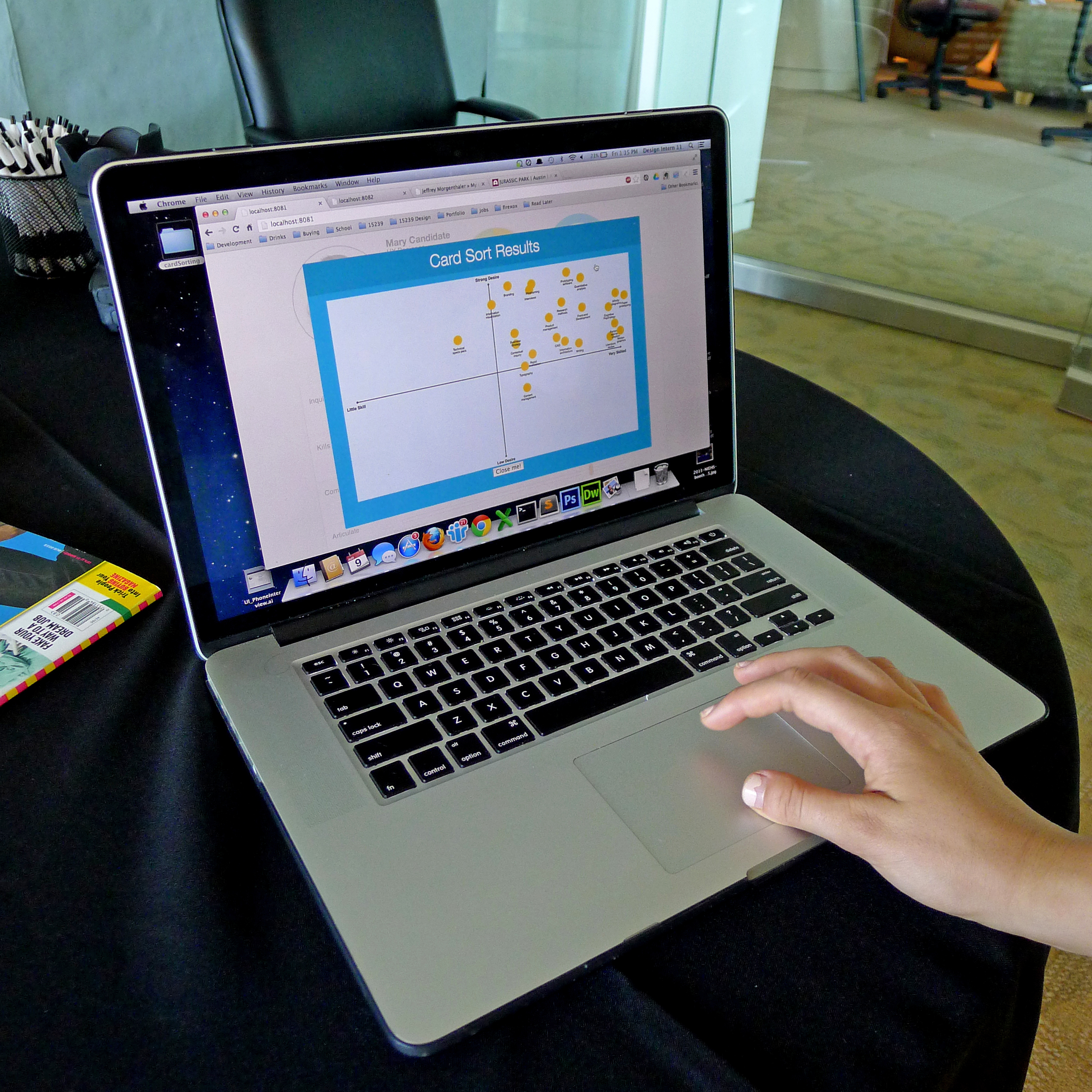4 designer team | 6 weeks | IBM Design | 2013
PROJECT oVERVIEW
My intern cohort was tasked with redesigning the recruiting, evaluation and hiring process for IBM Design. My group focused on the evaluation stage, from candidate interest to offer. We aimed to tackle both the recruiters known problems: difficulty managing candidate data, and the scalability of their recruiting efforts, as well as additional problems we uncovered from our research.
To do so, we ended up designing a software tool to help input, output and compute candidates' data and status, and an improved recruiting process. I led efforts to create an improved recruitment process, and assisted in designing the web-based application concept.
IMPROVED RECRUITING PROCESS
CONCEPT OVERVIEW
The improved process is designed to assess candidates more thoroughly and accurately without creating additional burden on the recruiting and reviewing staff. It creates targeted opportunities to assess candidates on each of the key criteria while avoiding time-wasting duplication of efforts. It is scalable to meet the high volume of IBM recruiting, and it offers cost savings over the current process.
FINAL DELIVERABLES
1. FLOWCHART AND SERVICE BLUEPRINT OVERVIEWS
The flow chart provides an overview of the process, while huge service blueprint shows the process step-by-step with swim lanes for each of the moving pieces in the system: recruiters, reviewers, candidates and system inputs and outputs.
2. EXPERIENCE PROTOTYPE & LIVE DEMO
Our final presentation entailed a walkthrough of the entire recruiting process from a candidates first interest through the welcome package after they accept an offer. Our assessment section was depicted through a combination of photo slideshow and live skit which helped demonstrate how the process and the app complement one another, and how they jive with the candidate experience.
3. HIRING CRITERIA & EVENT GUIDELINES
Since this process would be further developed and implemented after the internship program was completed, I created additional written documentation to help the team act on our findings and recommendations. I created a concrete list of the key traits IBM Design is looking for in candidates, and organized them into a clear and compelling composite with the acronym MAST. It combines qualities the management team intends to uncover with the current process, as well as additional criteria we found latent need for based on our interviews. I also created a thorough briefing for recruiting staff breaking down each event, which candidate assessment criteria are to be evaluated, and what is required for candidates to move forward.
RECRUITMENT MANAGEMENT APP
CONCEPT OVERVIEW
The recruitment management app is a sophisticated web-based application that intends to replace the spreadsheet, post-it note & email system currently in use to keep track of candidates in the hiring pipeline. It allows recruiters and reviewers to input information about each candidate quickly and easily, ensuring that meaningful insights are captured, and no assessment criteria are overlooked. It then outputs candidate records and reports to allow recruiters to monitor candidates’ progress through the process and delegate assessment responsibilities.
FINAL DELIVERABLES
1. HTML PROTOTYPES FOR KEY SCREENS
I worked with Jeff, a front-end-savvy designer on our team, to create a couple of HTML prototype screens to help communicate our approach. The first aimed to show how we would help evaluators consider and input the right metrics when interviewing a candidate (first screen below). The second shows the candidate overview. This screen aims to give a hiring manager an objective, and comprehensive, yet at-a-glance view of a candidate. It shows a candidate's designer type, strengths, weaknesses and evaluations (and even top comments) right in one view.
The visual and interaction details still needed alot of work, but creating screens, however imperfect, help us show how a data-driven approach could actually work. .
2. CANDIDATES SKILLS & INTEREST MAP
One part of the application we were concepting was a tool that helps represent candidates’ strengths and interests visually, so that a reviewer could figure out what “flavor” designer a person was quickly, and somewhat objectively.
This was in response to a concern that candidates would often misidentify their specialty, and therefore the wrong reviewer would receive their application. We also thought that being able to get the right mix of different designers on a team could help optimize the talent pool even further. Our teammate David Munoz took the lead further developing, prototyping and testing this idea and has a more detailed account of that process on his website.
3. SYSTEM REQUIREMENTS & OVERVIEW
Similar to with the recruiting process, since this tool would hopefully be further developed and implemented after the internship program was completed, I created additional documentation that showed all of the inputs and outputs for the system, and our approach to tracking the candidate, and showing where they stand.
PROCESS PRESENTATION
This flip created a few years ago covers some of the key process moments and the major research insights that informed our approach.












